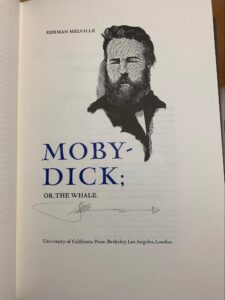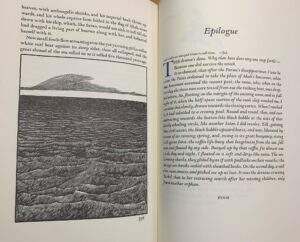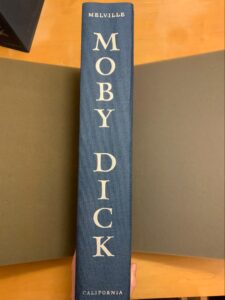According to the Reception theory of literature, audiences actively construct texts they read by bringing their unique interpretations, experiences, and judgements to their examination — Moby-Dick; or, the Whale is a fitting example of how perceptions of a book may skew its meaning and cultural value (Jauss). Specifically, the life of Moby Dick demonstrates how intended audiences shift based on certain aspects of the physical book and the cultural moments in which it was distributed. In this blog post, I will explore the intended versus actual demographics of readership of Moby Dick as it was published in its time, then hone in on the Arion Press editions of the book before examining the specific copy in the Dickinson Archives.
Moby Dick is filled with an unyielding level of detail in terms of whaling and intense moments from adventures at sea. When Melville set out to create this novel, his intended audience would be mentally worthy of handling scenes that detail the gory battles of whale hunting, or the complete madness and obsession of Ahab. Prior to the publication of his book, Melville warned his friend Sarah Morewood, “It is not a piece of fine feminine Spitalfields silk – but it is of the horrible texture of a fabric that should be woven of ships’ cables and hausers … Warn all gentle fastidious people from so much as peeping into the book – on risk of a lumbago & sciatics.” (“Moby-Dick.”). Although this comment is inferred to be made in a joking manner, ( Melville was not explicitly a feminist, but themes of femininity in a positive light were tied into nature and the presentation of several characters), his perceived audience was not composed of females — or “gentle fastidious people” — whose tastes were “too sensitive” for this book. Rather, more broadly, Melville’s intended audience would be progressive-minded people who could mentally handle depictions of gay marriage and subversions of gender norms. This may be why Moby Dick experienced a revival in the 1920s — more people were becoming comfortable with breaking conventions with the explosion of the “New Era” (Routledge). Therefore, the cultural value of this book has shifted and increased as societal mindsets evolved, hence Moby Dick’s new status as a masterwork of literature.
Moreover, the front matter of the book details the findings of a “sub-sub librarian,” serving as a comedic fragment Melville included 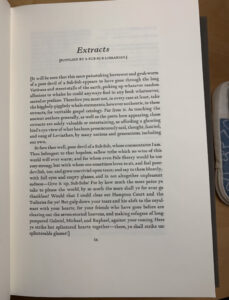 to indirectly engage in conversation with the audience (as seen in the front matter pictured here). This librarian is a thinly disguised representation of himself, considering he compiled the thorough references to whales (touching on their symbolic meaning that will be expanded upon) in past literature. However, at the time of publication, the public was widely unaccepting of Moby Dick. In a way, Melville may have undermined his credibility with his readers by introducing the self-deprecating sub-sub librarian. This epic work was a strict departure from the light-hearted adventures of his previous publications, and the playful introduction may have reinforced readers’ expectations that they were heading into an easy read about an adventure at sea. The harsh criticism and limited profitability negate Melville’s assumption of widespread admiration for his tragic work. Unfortunately, the failure of what he considered his magnum opus eventually led to the downfall of his career as a writer (Lagasse).
to indirectly engage in conversation with the audience (as seen in the front matter pictured here). This librarian is a thinly disguised representation of himself, considering he compiled the thorough references to whales (touching on their symbolic meaning that will be expanded upon) in past literature. However, at the time of publication, the public was widely unaccepting of Moby Dick. In a way, Melville may have undermined his credibility with his readers by introducing the self-deprecating sub-sub librarian. This epic work was a strict departure from the light-hearted adventures of his previous publications, and the playful introduction may have reinforced readers’ expectations that they were heading into an easy read about an adventure at sea. The harsh criticism and limited profitability negate Melville’s assumption of widespread admiration for his tragic work. Unfortunately, the failure of what he considered his magnum opus eventually led to the downfall of his career as a writer (Lagasse).
Furthermore, the Printer’s (also referred to as the AP) and California Deluxe editions of Moby Dick were not produced for high school students to fulfill their mandatory reading. Rather, the high-quality Printer’s edition was created for someone who enjoys revisiting the tale of Captain Ahab and his obsession with the white whale. The hefty price suggests that the reader must also appreciate the minute elements that establish the character of a physical book. The intended audience could range from passionate book collectors to university archives; currently on sale for $10,000 – $15,000, this book has become a valuable cultural product (“Arion Press Moby Dick, Printer’s Copy.”). On resale sites, the price increases to $25,000 (“Moby Dick or, the Whale.”). Therefore, this edition is not used for constant rereading, bookmarking, and dog-earing. Rather, the book is representative of the appreciation of the storytelling and act of creation of the physical book — it could serve as a centerpiece or a lavish adornment to a coffee table. The thought put into this book is representative of the significance this book holds in our culture, widely considered one of the greatest American novels. Components including the size, quality of paper, condition of the binding, and presence of thoughtful, handcrafted details all signify that this edition is worthy of that prestige, a tribute to Melville’s success that was deserved when he was alive.
The original publication of the book indicates the intended success of Moby Dick. Released in the UK and America, the first edition
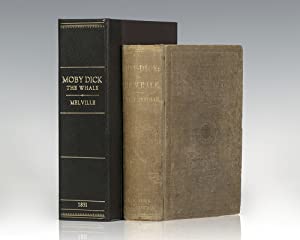
First edition of Moby Dick, Published by Harper & Brothers, New York, 1851
was a work of art in itself with golden gilt binding, however, the book was sold for $1.50 when published in 1851 (Kuhl). Although the book was not published cheaply, only 915 copies were printed in Melville’s lifetime. A helpful comparison is made to the print run of Uncle Tom’s Cabin, published a year after Moby Dick, which “ sold 10,000 copies in 2 weeks” (Kuhl). The failure to sell copies reflects the notion that the audience of the time completely shapes the value of the book. However, as literary tastes developed, the book gained popularity and appreciation, as seen in Arion Press’s homage to Melville’s accomplishment.
The California Deluxe edition has an intended audience similar to the Printer’s edition. The most prominent difference between the two is that the California Deluxe edition possesses photographic representations of the original. Moreover, this edition is slightly smaller with a cloth cover rather than goat skin. The size of the book still denotes an elevated status, one that deserves a spot in a prized collection or on display despite being less expensive than the Printer’s edition. Currently, copies of this edition are being sold on online marketplaces like Abebooks, on which prices range from $250 to $1,726, depending on the condition, denoting a dedicated audience that holds a deep admiration for bookmaking (“Moby Dick or, the Whale.”). The copies available for purchase are being sold by independent bookstores instead of individuals. This suggests that private owners may be reluctant to sell their books or are utilizing alternative sales methods.
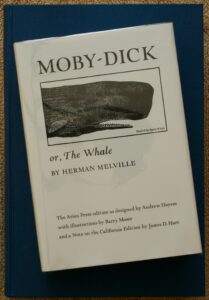
Trade Edition
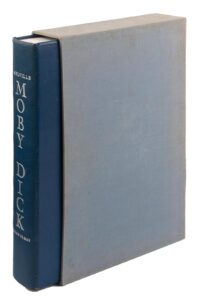
California Deluxe Edition
Arion Press also released a trade edition that was produced to transfer these finely crafted books into the hands of the public. With this, the audience has shifted to individuals who enjoy reading, but who are unwilling to spend more extreme sums on a single book. This edition was more economically reasonable due to its decreased size, all black rather than blue ink, and thinner paper. This edition aligns with Melville’s intended audience, which was likely a large portion of the population with progressive minds who will thoroughly enjoy the book for its thrill and thoughtfulness.
In terms of the California edition that Dickinson currently owns, the book’s journey to our archives has been touched on in my previous posts. In 2001, Friends of Dickinson College Library invited Barry Moser to deliver an engaging talk detailing his experiences as an artist in the printing industry. The 2002 Fall edition of the Dickinsonian newspaper reports on Moser’s experience at the college and the purchasing of books prior to his visit. Moby Dick was simply one out of seventy-five works acquired by the library to showcase Moser’s wide variety of works that spanned from classic literature to children’s books.
The California Deluxe edition of Moby Dick currently resides in the archives, which explains the near pristine condition of the book. Since this edition is less than 50 years old, this copy has not required any sort of retouching or rebinding. Most importantly, with the repossession of the book from a seller to our school, the audience has been transformed once again – now, readers include students with an interest in historical books, or members of the public who visit the archive for research or personal enjoyment. Throughout this book’s lifetime, its audience is likely to shift again.
Works Cited
“Arion Press Moby Dick, Printer’s Copy.” Moby-Dick; or, the Whale – Price Estimate: $10000 – $15000, https://www.pbagalleries.com/view-auctions/catalog/id/474/lot/155860/Moby-Dick-or-The-Whale.
Davis, J. “Moby Dick; Published by University of California Press & Arion Press.” The Whole Book Experience, 14 Sept. 2014, https://www.thewholebookexperience.com/2014/09/13/moby-dick-published-by-university-of-california-press-arion-press/.
Jauss, Hans Robert, and Timothy Bahti. Toward an Aesthetic of Reception. University of Minnesota Press, 1982.
Kuhl, Nancy. “Moby Dick: Context and Resources.” Beinecke Rare Book & Manuscript Library, 16 Sept. 2020, beinecke.library.yale.edu/article/moby-dick-context-and-resources.
Marcus, Greil. “1851: ‘Give It up, Sub-Subs!”: A New Literary History of America.” Credo Reference, Harvard University Press, 2009, https://search.credoreference.com/content/entry/harvardhoa/1851_give_it_up_sub_subs/0.
“Melville, Herman.” The Columbia Encyclopedia, Paul Lagasse, and Columbia University, Columbia University Press, 8th edition, 2018. Credo Reference, https://dickinson.idm.oclc.org/login?url=https://search.credoreference.com/content/entry/columency/melville_herman/0?institutionId=2613. Accessed 12 May 2023.
“Moby-Dick.” Brewer’s Curious Titles, edited by Ian Crofton, Chambers Harrap, 1st edition,
- CredoReference, https://dickinson.idm.oclc.org/loginurl=https://search.credoreferen
e.com/content/entry/orioncurious/moby_dick/0?institutionId=2613. Accessed 20 Apr.
2023.
“Moby Dick or, the Whale.” AbeBooks, University of California Press, Berkeley, Los Angeles and London, https://www.abebooks.com/book-search/title/moby-dick/kw/arion/used/.
“R. Michelson Galleries.” R MICHELSON GALLERIES, www.rmichelson.com/artists/barry-moser/. Accessed 11 May 2023.
Routledge, Christopher. “Moby Dick; or, the Whale 1851.” Encyclopedia of the Romantic Era, 1760-1850, edited by Christopher John Murray, 1st edition, 2003. Credo Reference, https://dickinson.idm.oclc.org/login?url=https://search.credoreference.com/content/entry/routromanticera/moby_dick_or_the_whale_1851/0?institutionId=2613. Accessed 12 May 2023.
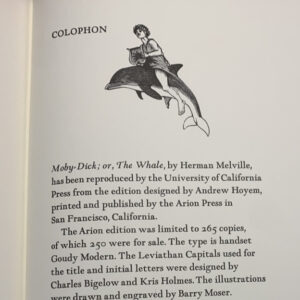 most prominent force in the company. He was closely involved in the executive decisions for design and course of action for the book, and oversaw the mechanical tasks regarding the production of the text (“About Arion Press”, www.arionpress.com). Moreover, the team of Bigelow and Holmes toiled over the design of the custom-made Leviathan typeface, attempting to bring the significance of the writing into a visual composition. For the bulk of the text, Bigelow and Holmes used the Goudy modern font, a variation of the Goudy open with the letters filled in (“Goudy Modern in use”, www.fontsinuse.com). Moreover, Barry Moser was commissioned to complete 100 wood-engraved illustrations for the book, and he was challenged by restrictions to not portray pivotal action scenes or major characters (“A Note on the California Edition”). Notably, the book is a clear distinction from identically mass-produced works, in which excellence is sacrificed for a lower price.
most prominent force in the company. He was closely involved in the executive decisions for design and course of action for the book, and oversaw the mechanical tasks regarding the production of the text (“About Arion Press”, www.arionpress.com). Moreover, the team of Bigelow and Holmes toiled over the design of the custom-made Leviathan typeface, attempting to bring the significance of the writing into a visual composition. For the bulk of the text, Bigelow and Holmes used the Goudy modern font, a variation of the Goudy open with the letters filled in (“Goudy Modern in use”, www.fontsinuse.com). Moreover, Barry Moser was commissioned to complete 100 wood-engraved illustrations for the book, and he was challenged by restrictions to not portray pivotal action scenes or major characters (“A Note on the California Edition”). Notably, the book is a clear distinction from identically mass-produced works, in which excellence is sacrificed for a lower price.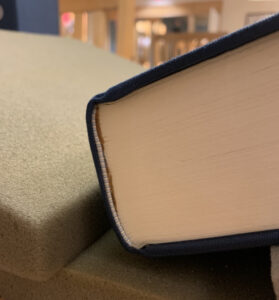
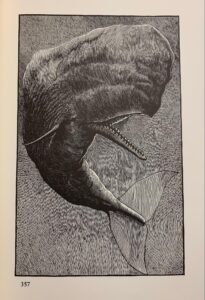
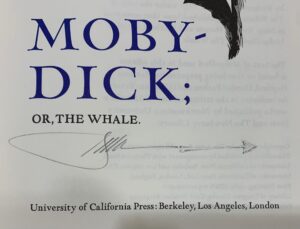
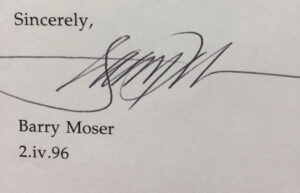
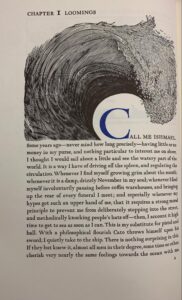 ng engravings spotlighted in works such as Dante’s Inferno and a vividly detailed King James Bible (“A Brief History of Pennyroyal Press”). One can see the texture of the engravement, detailed by small slashes and stark contrasts between ink and paper. James D. Hart asserts that primary characters are never illustrated to allow the readers to imagine their faces — instead, technical depictions of boats and whales are sprinkled throughout the text (“A Note on the California Edition”). Notably, the famous first line of Moby Dick is amplified by the dramatic illustration of a monumental wave that skillfully incorporates the curvature of the first letter C, marrying the text and the artwork.
ng engravings spotlighted in works such as Dante’s Inferno and a vividly detailed King James Bible (“A Brief History of Pennyroyal Press”). One can see the texture of the engravement, detailed by small slashes and stark contrasts between ink and paper. James D. Hart asserts that primary characters are never illustrated to allow the readers to imagine their faces — instead, technical depictions of boats and whales are sprinkled throughout the text (“A Note on the California Edition”). Notably, the famous first line of Moby Dick is amplified by the dramatic illustration of a monumental wave that skillfully incorporates the curvature of the first letter C, marrying the text and the artwork.